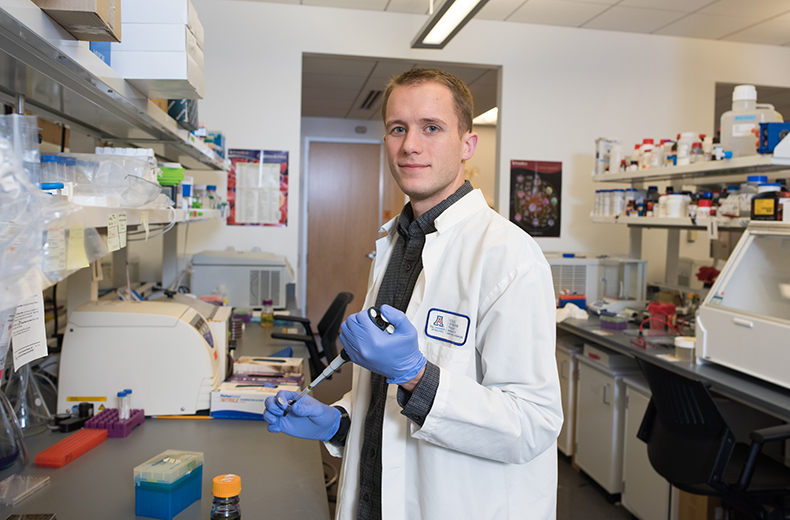
Study Finds Inflammatory Protein Can Protect Against Spread of Herpes Virus

Researchers at the University of Arizona College of Medicine – Phoenix have discovered a function in a pro-inflammatory protein that could play an important part in improving current and future therapeutics for the herpes virus.
The study, published in October in the Journal of Immunology, investigated whether the protein IL-36y is an essential component of the immune response to a herpes infection, or if other mechanisms can compensate for the lack of IL-36y.
Cytokines, proteins essential to the immune system, coordinate the response to pathogens and allow for cell-to-cell communication. IL-36y is a pro-inflammatory cytokine identified 20 years ago. Over the years, researchers have shown that it exhibits an important function in chronic inflammatory diseases, but only recently have scientists studied its role in infectious diseases such as herpes.
“We were the first group to detect IL-36y in the female reproductive tract and have been extending this work to evaluate the extent that this molecule can protect against, or contribute to, genital infection,” said Melissa Herbst-Kralovetz, PhD, senior and corresponding author of the study and associate professor in the Department of Basic Medical Sciences at the College of Medicine – Phoenix.
The study was led by Jameson Gardner, a graduate research student in the laboratory of Dr. Herbst-Kralovetz.
“Researchers have worked for decades to develop a vaccine to protect against genital herpes, but none has successfully passed through clinical trials,” Gardner said.
“These efforts have taught us so much about the immune response in the female reproductive tract, but the lack of success potentially indicates that we need to better understand important underlying immune mechanisms in the female reproductive tract as we seek to improve women’s health.”
Despite the widespread use of antiviral medications to treat genital herpes, more than 260 million women worldwide are living with this lifelong infection and transmitting it to new individuals daily.
After the initial genital herpes simplex virus 2 (HSV-2) infection in the vaginal epithelium, the virus spreads through the nervous system, where it establishes latency. The virus goes into “hiding,” where it persists for a lifetime and periodically reactivates, causing lesions.
“We really were excited to see that after intravaginal HSV-2 infection, the virus was able to spread systemically throughout the nervous system and to the brain in those lacking IL-36y, whereas our control group, which had the gene intact, was significantly more protected against HSV-2 spread in the nervous system,” Gardner said. “We’ve shown that IL-36y appears to function in a previously uncharacterized manner to protect against virus neuroinvasion (an infection that affects the nervous system).”
“We stumbled across this neuroinvasion finding and we were able to confirm that IL-36y is limiting the spread of virus from the genital tract to the nervous system,” Dr. Herbst-Kralovetz said.
The precise mechanism in which IL-36y protects against neuroinvasion is unknown, but is an exciting and important area of future research.
In addition, researchers concluded IL-36y played a critical role in recruiting neutrophils, a type of white blood cell that protects against invading pathogens.
“Our understanding of how IL-36y functions can aid in the development of novel therapeutics to protect against – and hopefully decrease – the burden of STIs around the world,” Gardner said.
“The global disease burden of sexually transmitted infections is huge, and this work helps us to better understand the role IL-36y plays in the female reproductive tract and how that could impact women’s health in general.”
Research funding was supported by a National Institutes of Health grant: 1R15AI113457-01A1 (Herbst-Kralovetz). Other funding includes support by the Valley Research Partnership Grant P12 (Herbst-Kralovetz and Gardner).
About the College
Founded in 2007, the University of Arizona College of Medicine – Phoenix inspires and trains exemplary physicians, scientists and leaders to advance its core missions in education, research, clinical care and service to communities across Arizona. The college’s strength lies in our collaborations and partnerships with clinical affiliates, community organizations and industry sponsors. With our primary affiliate, Banner Health, we are recognized as the premier academic medical center in Phoenix. As an anchor institution of the Phoenix Bioscience Core, the college is home to signature research programs in neurosciences, cardiopulmonary diseases, immunology, informatics and metabolism. These focus areas uniquely position us to drive biomedical research and bolster economic development in the region.
As an urban institution with strong roots in rural and tribal health, the college has graduated more than 1,000 physicians and matriculates 130 students each year. Greater than 60% of matriculating students are from Arizona and many continue training at our GME sponsored residency programs, ultimately pursuing local academic and community-based opportunities. While our traditional four-year program continues to thrive, we will launch our recently approved accelerated three-year medical student curriculum with exclusive focus on primary care. This program is designed to further enhance workforce retention needs across Arizona.
The college has embarked on our strategic plan for 2025 to 2030. Learn more.